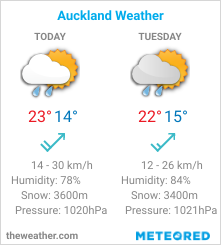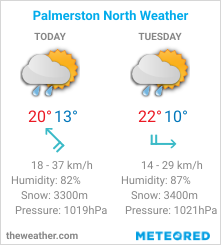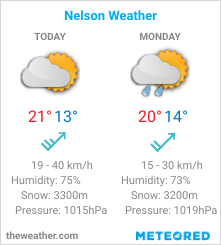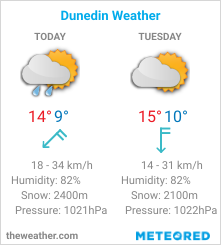CONTAINER VESSEL MSC BRASILIA BERTHED IN WELLINGTON FEB. 2012
PrimePort secures new shipping service
Weekly container service to begin Oct 10
PrimePort Timaru has secured a new weekly container service for the port - saving 10 jobs.
The Mediterranean Shipping Company (MSC) will begin a weekly container service through the port on October 10.
The new service comes in the wake of global container lines Maersk and Hamburg Sud withdrawing their services from Timaru earlier this month. The loss of that trade meant 42 positions would be lost and 23 new roles created.
The new service will give exporters a direct weekly service to Asia and Australia with connections to the USA, Europe and other parts of the world.
"This is an ideal solution for the many local exporters who have been exposed to the harsh alternatives of transporting product out of the region that was clearly going to be expensive and difficult to manage," PrimePort chief executive Jeremy Boys said in announcing the new service.
"In many respects this new service enhances the choice and improves on the previous service we had."
Iran launches Tareq 901 submarine, Sahand destroyer
 Iran's Navy has launched the overhauled super-heavy Tareq 901 submarine and indigenous Sahand destroyer in the southern port of Bandar Abbas Sept. 18 Iran's Navy launched the overhauled super-heavy submarine and indigenous destroyer on Tuesday as the United States and its allies continued military drills in the Persian Gulf for the third day.
Iran's Navy has launched the overhauled super-heavy Tareq 901 submarine and indigenous Sahand destroyer in the southern port of Bandar Abbas Sept. 18 Iran's Navy launched the overhauled super-heavy submarine and indigenous destroyer on Tuesday as the United States and its allies continued military drills in the Persian Gulf for the third day.
The super-heavy Tareq 901 submarine repaired by Iranian experts and Sahand destroyer were successfully launched in Iran's southern port of Bandar Abbas.
Iranian Foreign Ministry Spokesman Ramin Mehmanparast said Tuesday that Iran is monitoring every move in the Persian Gulf " carefully."
Making the remarks in his weekly press briefing, Mehmanparast referred to the ongoing military drill of the United States and its allies in the Persian Gulf, and said the security and stability of the Persian Gulf is of "high priority" for Iran and the country will confront any measure that causes instability and insecurity in the region.
"Iran has emphasized that the root cause of insecurity in the region is the military presence of foreigners and Westerners," he said.
With respect to the defensive power of the regional countries and the cooperation and convergence among them, there is no need for foreigners in the region, Mehmanparast said, adding that powerful states of the region are able to establish stability and security in collaboration.
The United States and about 25 of its allies started Sunday the largest-scale mine-sweeping exercise in the Persian Gulf, in a show of unity and defensive step to prevent Iran from attempting to block oil exports through the Strait of Hormuz.
Iranian military officials have threatened to close the Strait of Hormuz in the face of mounting western sanction pressures.
In August, Iran's defense minister has said that his ministry plans to produce a variety of fighter jets, missiles, drones, submarines and military vehicles by the end of the Iranian calendar year (started on March 20, 2012).
The West suspects Iran of attempting to produce a nuclear warhead under cover of its nuclear program, while Iran says its nuclear program is for peaceful purposes only.
Super-heavy Tareq 901 submarine (file photo)
The super-heavy Tareq 901 submarine repaired by Iranian experts and Sahand destroyer were successfully launched in Iran's southern port of Bandar Abbas.
Iranian Foreign Ministry Spokesman Ramin Mehmanparast said Tuesday that Iran is monitoring every move in the Persian Gulf " carefully."
Making the remarks in his weekly press briefing, Mehmanparast referred to the ongoing military drill of the United States and its allies in the Persian Gulf, and said the security and stability of the Persian Gulf is of "high priority" for Iran and the country will confront any measure that causes instability and insecurity in the region.
"Iran has emphasized that the root cause of insecurity in the region is the military presence of foreigners and Westerners," he said.
With respect to the defensive power of the regional countries and the cooperation and convergence among them, there is no need for foreigners in the region, Mehmanparast said, adding that powerful states of the region are able to establish stability and security in collaboration.
The United States and about 25 of its allies started Sunday the largest-scale mine-sweeping exercise in the Persian Gulf, in a show of unity and defensive step to prevent Iran from attempting to block oil exports through the Strait of Hormuz.
Iranian military officials have threatened to close the Strait of Hormuz in the face of mounting western sanction pressures.
In August, Iran's defense minister has said that his ministry plans to produce a variety of fighter jets, missiles, drones, submarines and military vehicles by the end of the Iranian calendar year (started on March 20, 2012).
The West suspects Iran of attempting to produce a nuclear warhead under cover of its nuclear program, while Iran says its nuclear program is for peaceful purposes only.
Devonport frigate could be sunk as reef for diving
The prospect of a once Devonport-based Type 22 frigate being deployed as a dive wreck has emerged after campaigners missed out on securing the former Navy flagship,HMS Ark Royal. Earlier this week, the Ministry of Defence (MoD) announced it was selling the iconic vessel to a Turkish scrap metal firm in a £3 million deal.
It appeared to dash the hopes of the Wreck the World project, which wanted the 22,000-ton aircraft carrier to be turned into a diving wreck off the Torbay coast. But, in a letter to Devon MP Sarah Wollaston, Defence Minister Philip Dunne suggested that one of four Type 22 frigates scrapped by the Government last year "might be more suitable for use as dive wrecks". The Type 22 fleet of HMS Campbeltown, HMS Chatham, HMS Cornwall and HMS Cumberland were all based in Plymouth, and are expected to be "laid up" in Portsmouth until their final disposal.
In the last few months the RN has paid off submarine HMS Trafalgar, aircraft carrier HMS Ark Royal, 4 frigates; HMS Cornwall, HMS Chatham, HMS Campbeltown, & Cumberland and 2 destroyers; HMS Manchester & HMS Gloucester, 3 auxiliaries; RFA Fort George, RFA Largs Bay & RFA Bayleaf. Of the few new vessels joining the fleet, the 3 new Type 45 destroyers are not ready to be deployed on operations and submarine HMS Astute’s epic sea trails have been dogged by bad luck. The only other ship to join the RN is HMS Protector – a Norwegian ice-breaker which should be a good replacement for HMS Endurance.
HM Government may not want to pay for a navy, but they certainly have a need for one. The danger here is not in the loss of ships, grievous though the losses be. As the legendary Admiral Cunningham noted during his operations at Crete in 1941: "It takes three years to build a ship; it takes three centuries to build a tradition." The ships that are being decommissioned now can, in time, be replaced. What cannot as easily be replaced is the skill, experience and esprit de corps of those who man the fleet today. That is a vital tradition that can be lost just as easily in peace as in war.
TYPE 22 FRIGATE HMS CORNWALL
Scotlands Maritime Legacy
Clydebuilt. The expression comes from the days when Scotland was the greatest shipbuilding nation on earth and was once a byword for quality, synonymous with solidity and reliability. It conjures up images of the late nineteenth and early twentieth century, when the banks of the Clyde from Greenock to Glasgow were lined with shipyards, where tens of thousands of men built great ocean liners and warships, towers of steel rising majestically against the sparkling waters of the west coast.
The Clyde was naturally a shallow waterway as low as two feet at low tide and this hampered Glasgows ambitions as a port. In 1768 a sequence of dykes was built, narrowing the channel and greatly increasing the flow of water, which in turn scoured the bed and deepened the river. The Clydes entry into the world of shipbuilding could begin and The Comet Europes first sea-going steam ship was launched at Port Glasgow in 1812.
Shortly after this one of the worlds most iconic ships was launched at Dumbarton, a little further along the coast. The Cutty Sark was designed by the Glasgow firm of Scott and Linton and its design incorporated the midship attributes of Firth of Forth fishing boats, creating a hull shape stronger than any before it and allowing the ship to take more sails and be driven harder than almost any other clipper. In the late nineteenth century the Cutty Sark become one of the fastest sail-ships in the world, making record times between Britain and Australia.
The dawn of a new era
However, a new era was around the corner, and the dawning of the twentieth century saw the Clyde shipyards producing a new generation of ocean liners; ships like the SS Persia and the Lusitania.
The Persia was built at Greenock in 1900. She clocked in at 500 feet in length, weighed over 8,000 tonnes and could achieve a maximum speed of over 30 MPH; speed and tonnage which eclipsed anything achieved by wooden sailboats like the Cutty Sark. The Persia herself was to be dwarfed only six years later by a new ship under construction on the Clyde. When the Lusitania was launched in the summer of 1906 she became the largest ship afloat: almost eight hundred feet long and weighing 31,550 gross tonnes she was designed to be the last word in speed and luxury offering passengers a swift trip across the Atlantic in five star comfort.
Casualties of WW1
However, the First World War was to spell doom for both ships.
In May 1915 the Lusitania was on her way back from New York, and had the coastline of Ireland within sight, when she was torpedoed by the German U-Boat U-20. The great ship went down in 18 minutes, taking 1,195 lives with her; among them were 123 Americans and the tragedy undoubtedly hastened US entry into WWI. Then, just six months later, on the day before New Years Eve 1915, the SS Persia was sailing 71 miles south east of Crete when at 1.10 pm, just as many of the passengers were sitting down to lunch she was struck on the port bow by a German torpedo. Minutes later the port boiler exploded and the ship sank so rapidly that only four of her lifeboats escaped. 334 of the 500 passengers went with the ship to the bottom of the Mediterranean ten thousand feet below, along with a great quantity of gold and jewels belonging to the Maharaja Jagatiji Singh.
Among the survivors was half-Scot John Walter Edward Douglas-Scott-Montagu, the 2nd Baron Montagu of Beaulieu. His secretary and girlfriend Eleanor Thornton, who was the model for Rolls Royces Spirit of Ecstasy mascot, sadly lost her life in the sinking. In the space of six short months two magnificent examples of Scottish industry and engineering lay on the floor of the ocean.
The next generation of liners
By the end of the 1920s one of the next generation of liners, and one of the most iconic vessels in history, was under construction at John Browns shipyards in Clydebank, Glasgow. At over one thousand feet in length, weighing in at 80,000 tonnes, and with a top speed of over 30 knots, theQueen Mary would dwarf the ships that had gone before her and reassert Britains dominance of the Blue Riband.
The Blue Riband was an unofficial title, awarded to the ship achieving the fastest transatlantic crossing, and it was frowned upon by the major shipping lines, who could not be seen to condone racing as it was contrary to safety policy. However, since the first transatlantic steamship crossings had begun in the mid-nineteenth century, ships and indeed nations had competed fiercely for the prize, the competition arguably reaching its peak with the intense rivalry between Britains Queen Mary and Frances Normandie in the 1930s. The Normandie reclaimed the prize in 1937 until the following year, when the Queen Mary won it back again, in the process setting a record speed for an Atlantic crossing which was to stand until 1952.
Too fast for the submarines
During WWII the Queen Mary was converted for military use and used to carry troops around the world, taking as many as 15,000 men on a single voyage. She was eventually joined by her sister ship the Queen Elizabeth and the two became known as the grey ghosts, the fastest troop ships in the war. Hitler understood what a blow to Allied morale it would be to sink the Mary and the Elizabeth and offered the Iron Cross and a bounty equivalent to 250,000 dollars in todays money to any U-Boat commander who sent them to the bottom. It proved impossible they were simply too fast for the submarines.
The Queen Mary continued in service for over twenty years after the war, dominating the transatlantic passenger trade. However, 1958 saw the first jet flight between London and New York: what had once taken several days now took several hours and the writing was on the wall. By the mid 1960s the Queen Mary was often pulling into New York harbour with more crew than passengers and in 1967, over thirty years after she was launched, Cunard bowed to the inevitable and retired her from service. Today she is a floating hotel in Long Beach, California, her only brushes with the glory of her early years coming when she is used as a location in Hollywood films like The Poseidon Adventure and Pearl Harbour.
Revolutionary new technologies
The great era of the steamships and colossal passenger liners is long past. Today, however, Scotland is at the forefront of key developments beneath the waves, in developing technologies which are making sure that no parts of the worlds oceans are unreachable.
Fife-based company Deep Tek have developed a revolutionary deep-sea recovery system called The Winder; 75 tonnes of machinery capable of allowing a remote-control platform to explore the deepest, most inaccessible waters. Key in this process is a unique cable developed by Deep Tek a fibre rope which is stronger than steel but much more buoyant at great depths.
In 2003, in what was the worlds deepest ever salvage operation, Deep Tek used the equipment to explore the wreck of the SS Persia, cut into the ships strongroom, and retrieve over 200 of the Maharajas rubies and other precious stones, treasures that had laid undisturbed since 1915. The Winder and the SS Persia: two triumphs of Scottish engineering separated by nine decades and 10,000 feet of water and brought together by Scottish ingenuity!
Unlocking the treasures of the sea bed
There are other applications too. Today the North Sea oil and gas industries in Scotland employ some 86,000 people and contribute around 16 billion pounds to the Exchequer. As these industries move into working in ultra-deep waters of over 2000 metres, fibre rope systems will come to play an increasingly vital role in getting essential machinery to the ocean floor and helping to unlock the mineral treasures below the sea-bed.
The sea-bed itself has been the cause of concern for environmentalists recently, as increasing damage is thought to have been done to it by the heavy dredging nets used by fishing trawlers. In heavily fished seas like the North Sea and the North Atlantic this dredging of the sea floor can cause serious damage to seabed sediments with knock-on effects for the species they support. Engineers from Aberdeen University are spearheading research into this phenomenon; sending divers down behind trawlers in underwater vehicles to survey the extent of the damage, with a view to developing new fishing methods which will be less harmful to the environment.
Where it once ruled the waves during the great era of shipping, Scotland is now playing an equally key role beneath the waves; both in terms of extracting vital resources and in protecting the environment which produces them.
Queen Mary is an imposing sight as she arrives in New York City
Second Astute Class Submarine Sets Sail on Sea Trials
The second Astute class submarine Ambush has set sail from BAE Systems to begin sea trials with the UK Royal Navy.
The 7,400 tonne attack submarine left the site in Barrow-in-Furness, Cumbria on Saturday September 15 for Her Majesty’s Naval Base (HMNB) Clyde, Faslane, which will become its operational base. This major milestone in the submarine programme is the point at which Ambush will begin to test its range of capabilities, under the control of Ambush Commanding Officer, Commander Peter Green and his crew.
BAE Systems Maritime – Submarines Managing Director John Hudson said: “This is the culmination of a tremendous amount of hard work from everyone at BAE Systems, our partners in the submarine enterprise and the hundreds of businesses in our supply chain network. Nuclear powered submarines are ferociously complicated, and it would not have been possible to reach the stage we are at today without the valued input of all those highly-skilled people.
“There now follows an extensive and rigorous period of testing during which we’re confident Ambush will go on to demonstrate herself as a fantastic capability.”
Commander Peter Green, said: “We are grateful to all the people who have worked hard to construct this vessel. The crew cannot wait to start sea trials and take this magnificent vessel a step closer to beginning operations. It is now time to start putting Ambush through her paces on sea trials and prove that this amazing piece of equipment is ready for operations.”
Ambush is the second in a planned class of seven submarines and she follows sister vessel HMS Astute to HMNB Clyde, in Scotland, where the first in class has been based since leaving BAE Systems in 2009. Minister for Defence, Equipment , Support and Technology Philip Dunne said: “Ambush and her sisters are the most powerful and advanced attack submarines ever ordered for the Royal Navy, they are needed by the fleet and they will play a vital role in the future defence of the UK. The completion of Ambush is a tribute to the hard work and commitment of the thousands of people employed in this country's world-class submarine industry.”
The Astute class boasts a range of world class capabilities inside each 97 metre long hull. Powered by a Rolls-Royce nuclear propulsion system, the reactor never needs refuelling. The sonar system has the processing power of 2,000 laptops and can track ships 3,000 miles away. They are armed with both Tomahawk land attack missiles and Spearfish torpedoes and her missiles have a target range of 1,200 miles with accuracy measured in metres. John Hudson added: “The skill at BAE Systems lies in the design, build, test and commissioning of the submarine and the complex integration of the highly sophisticated technology onboard, so everyone involved should feel justifiably proud of their achievements today.”
HMS Astute is currently on sea trials and in March this year successfully test fired four Tomahawks, and six Spearfish torpedoes, including the first salvo by a British submarine for 15 years, during trials in America. Source : DEFPRO
S120
AMBUSH
Ambush, second the Astute-class attack submarines, was named in Barrow on 16 December 2010 and launched on 5 January 2011. Having now completed her initial dive, she is in the final stages of fitting out whilst preparing for an extensive programme of sea trials. She will sail for her home port of Faslane in 2012.
THE FOLLOWING STORY FROM DARTMOUTH,
ENGLAND........
'I'm a pirate' shouted drunken woman before hijacking passenger ferry
A woman high on drink and drugs who stole a passenger ferry and crashed into boats shouting ''I'm Jack Sparrow'' has been jailed.
10:26AM BST 20 Sep 2012
A woman high on drink and drugs who stole a passenger ferry and crashed into boats shouting ''I'm Jack Sparrow'' has been jailed.
Reckless Alison Whelan, 51, was on a two-day bender when she climbed onto the moored 100-seater Dart Princess in Dartmouth, Devon.
Whelan was so drunk on Lambrini she dialled 999 and officers raced to the scene but she then unmoored the 45ft vessel and started drifting away.
She was heard shouting "I'm Jack Sparrow" and "I'm A Pirate" as she made her escape on the double-decker ferry.
But the boat then began hitting other vessels ''like a pinball machine'' - including a £70,000 catamaran, Torquay Magistrates Court in Devon heard.
The boat finally came to rest an hour later a mile upstream where lifeboats arrived to tow Whelan and her accomplice back to the harbour.
When arrested she claimed that she ''would have ended up in St Tropez'' if she hadn't been caught.
More than 30 ambulance, police, coastguard and RNLI officers were drafted in during the incident, a court heard.
Whelan, of Paignton, Devon, pleaded guilty to aggravated vehicle taking and was jailed for 122 days.
She caused thousands of pounds worth of damage, including £1,500 to the ferry itself and £300 to a moored vessel called Tomcat.
Speaking after the hearing, PC Clare Pearson said: ''This lady put the police, ambulance and coastguard to an awful lot of trouble.
''The amount of people called out to recover the boat and the damage caused to other vessels made it quite an expensive night."
Whelan had been drinking Lambrini and eating poisonous hallucinogenic plants when she headed to the ferry late at night on September 10, 2011.
The boat is usually used for wildlife cruises the Torbay area but had been hired for a different job and was moored in nearby Kingswear.
Whelan and her friend Tristam Locke climbed aboard and she then dialled 999 and said she thought she was having a seizure.
Paramedics arrived and found the defendant "rambling" and drunk while Locke became abusive and pushed one of the medics over.
Ambulance technician Peter Jordan said he and his colleague waited in their vehicle a few yards away from the ferry for police to arrive.
They then watched through the wing mirror as the ferry started to move.
Witnesses say the boat then began drifting ''like a pinball machine'' down the River Dart as Whelan shouted ''I'm Jack Sparrow, I'm A Pirate'', the court heard.
Ambulance technician Peter Jordan said: "We saw it drifting down the estuary.
"I heard a female voice saying they were pirates and asking what are we going to do now?"
Police arrived and were told the suspects were 200 yards away and heading towards dozens of other moored vessels.
Whelan later told police she untied two or three of the ropes connecting the boat to the shore because she kept tripping over them.
She said ''before she knew it'' she felt the boat moving and "noticed the hotels getting a long way away".
Police joined lifeboat crews on the river trying to intercept the boat and the harbour master was also alerted.
But the suspects shouted abuse from the out-of-control vessel and made jokes about being kidnapped, the court was told.
Whelan was heard taunting police by saying "what are you going to do now?" and "I believe this is out of your jurisdiction".
Officers watched as the boat span into a £70,000 fibreglass catamaran called Force Majeure and a moored vessel called Tomcat.
It finally came to rest in still water about a mile upstream where lifeboats arrived to ferry them back to the harbour.
Whelan admitted that she and Locke had been on a drinking spree and consumed deadly nightshade, which caused her to hallucinate.
She admitted she could get a "bit cocky" when drunk but said she panicked when she saw the police.
The court the ferry had been moored securely with seven ropes an hour or so before it was taken and was not seriously damaged.
Ashley Lane, the ferry's operations manager, said the would-be sailors were both "exceptionally lucky to be alive".
He said: "If the tide had been going out instead of coming in the boat could have been pulled onto rocks and the two of them could have been killed."
Magistrates had to decide whether Whelan, a chronic alcoholic who is awaiting a liver transplant, unhitched all the ropes knowing she would float away.
When arrested she claimed that she ''would have ended up in St Tropez'' if she hadn't been caught.
More than 30 ambulance, police, coastguard and RNLI officers were drafted in during the incident, a court heard.
Whelan, of Paignton, Devon, pleaded guilty to aggravated vehicle taking and was jailed for 122 days.
She caused thousands of pounds worth of damage, including £1,500 to the ferry itself and £300 to a moored vessel called Tomcat.
Speaking after the hearing, PC Clare Pearson said: ''This lady put the police, ambulance and coastguard to an awful lot of trouble.
''The amount of people called out to recover the boat and the damage caused to other vessels made it quite an expensive night."
Whelan had been drinking Lambrini and eating poisonous hallucinogenic plants when she headed to the ferry late at night on September 10, 2011.
The boat is usually used for wildlife cruises the Torbay area but had been hired for a different job and was moored in nearby Kingswear.
Whelan and her friend Tristam Locke climbed aboard and she then dialled 999 and said she thought she was having a seizure.
Paramedics arrived and found the defendant "rambling" and drunk while Locke became abusive and pushed one of the medics over.
Ambulance technician Peter Jordan said he and his colleague waited in their vehicle a few yards away from the ferry for police to arrive.
They then watched through the wing mirror as the ferry started to move.
Witnesses say the boat then began drifting ''like a pinball machine'' down the River Dart as Whelan shouted ''I'm Jack Sparrow, I'm A Pirate'', the court heard.
Ambulance technician Peter Jordan said: "We saw it drifting down the estuary.
"I heard a female voice saying they were pirates and asking what are we going to do now?"
Police arrived and were told the suspects were 200 yards away and heading towards dozens of other moored vessels.
Whelan later told police she untied two or three of the ropes connecting the boat to the shore because she kept tripping over them.
She said ''before she knew it'' she felt the boat moving and "noticed the hotels getting a long way away".
Police joined lifeboat crews on the river trying to intercept the boat and the harbour master was also alerted.
But the suspects shouted abuse from the out-of-control vessel and made jokes about being kidnapped, the court was told.
Whelan was heard taunting police by saying "what are you going to do now?" and "I believe this is out of your jurisdiction".
Officers watched as the boat span into a £70,000 fibreglass catamaran called Force Majeure and a moored vessel called Tomcat.
It finally came to rest in still water about a mile upstream where lifeboats arrived to ferry them back to the harbour.
Whelan admitted that she and Locke had been on a drinking spree and consumed deadly nightshade, which caused her to hallucinate.
She admitted she could get a "bit cocky" when drunk but said she panicked when she saw the police.
The court the ferry had been moored securely with seven ropes an hour or so before it was taken and was not seriously damaged.
Ashley Lane, the ferry's operations manager, said the would-be sailors were both "exceptionally lucky to be alive".
He said: "If the tide had been going out instead of coming in the boat could have been pulled onto rocks and the two of them could have been killed."
Magistrates had to decide whether Whelan, a chronic alcoholic who is awaiting a liver transplant, unhitched all the ropes knowing she would float away.
Thanks to Shipmate Bob Pinker for this story
For those unfamiliar with the movies, Jack Sparrow is the main character in the Pirates of theCaribbean films; he's a very odd sort of pirate. The woman who thought that she was channeling him was Alison Whelan, and according to all reports, she was drunk and high, having been "drinking Lambrini and eating poisonous hallucinogenic plants." Lambrini is an alcohol made from pears.
++++++++++++++++++++++++++++++
The woman below could have been the same
'Jack Sparrow' above.
Blonde wife texts husband on a cold winter's morning: "Windows frozen."
Husband texts back: "Pour some luke warm water over it."
Wife texts back: "Computer really buggered now."
Husband texts back: "Pour some luke warm water over it."
Wife texts back: "Computer really buggered now."










No comments:
Post a Comment
How did you like the post, leave a comment. I would appreciate hearing from you all. Best wishes from JC's Naval, Maritime and Military News